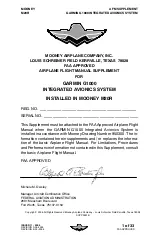
MGL Avionics Stratomaster Ultra “L” Owner’s manual
Page 30
Why include a barometer in an aircraft – this is a question we get asked often. Here is why:
Firstly and perhaps most obviously, it has uses when predicting frontal systems and general
weather forecasting. Sailors use it with great effect and much the same reasons apply for
many of us aviators.
The second reason however I value as the most important: To convince you that flying too
high in an unpressurised aircraft without added oxygen is not a good idea.
At an altitude of 12.000 ft (3 658 m), considered by many as limit for unaided ascent, the
barometer reading will be as little as 640 mb (18,9 Inch of Hg) even less depending on local
conditions at the time. Further considering that at sea-level you will be at around 1000-1025
mb (29,5 – 30,3 Inch of Hg) most of the time, you should easily see that you’re going to
deprive your lungs of badly needed oxygen. Many accidents have happened as a result.
TIME
The current time of day. This is set in the “user setup menu”. Should you often fly in
controlled airspace you may want to set the time to read UTC rather than local time. Date and
time of day are relevant for flight information stored in the logbook. The date and time
originates from a built in crystal controlled watch with low drift characteristics. You may need
to correct the time for small drift every few months. This is done in the “user setup menu”.
FLIGHT
The duration from take-off of the current flight or the duration of the last flight if no flight is
currently active.
Note: We recommend that you set the instrument to “automatic flight detect” in the mode
menu. Should you prefer manual flight start and stop then the FLIGHT timer will show the
time from the manual start of a flight to its manual stop.
Manual flights are started and stopped in the relevant menu item in the main menu.
GCR
Glide or climb ratio indicator. This useful item divides your forward distance made good by
your vertical speed. The ratio is shown as a number from 0.00 to 99.9. It should be
interpreted as follows:
Example: GCR 8.5. This means for every 1 ft (or meter) of vertical sink or climb you are
traveling 8.5 ft (or meters).
The arrow in front of the number indicates climb or sink rate. This function is useful to
optimize glide ratio or judge the effects of changes to your airframe or power plant.
TEMP
The ambient temperature. You need to install the included ambient temperature probe in
such a fashion that it is exposed to the outside air. Do not install the probe inside your cockpit
or instrument pod. Install the probe in such a fashion that it will not be heated by engine
exhaust or sunlight. Ambient temperature is required to calculate density altitude.
DIST
A flight distance trip counter similar to a trip counter in a car’s speedometer. The trip counter
is reset using the relevant menu entry in the main menu. You can also set the instrument to
reset the trip counter automatically at the start of a flight (mode setup menu). The trip



































